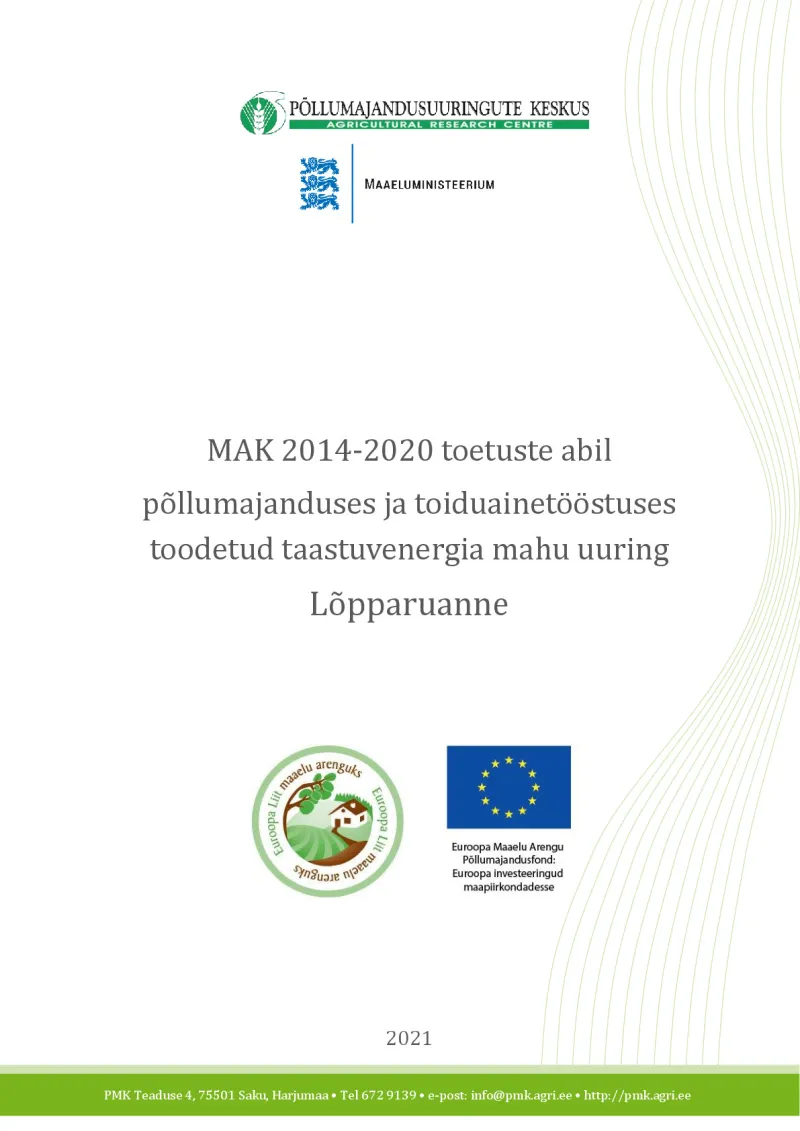Study on the volume of renewable energy produced in agriculture and the food industry
The aim of this study is to assess the Rural Development Programme (RDP) activities that contribute to the production of renewable energy in Estonia.
- Estonia
- 2014-2022
- Environmental impacts


In the mid-term evaluation of the Rural Development Programme (RDP) 2014–2020 conducted in 2019, it was found that it is not possible to accurately calculate the complementary result indicator (CRI 15) "Renewable energy production from supported projects", because the data for mandatory evaluation activities in focus area 5C (Renewable energy) of the RDP is insufficient. Since this is the essential input for the ex-post evaluation of the RDP, it is necessary to analyse and develop the methodology for calculating complementary result indicators (CRI15).
For this reason, the main objective of the study was to obtain an overall picture of the Rural Development Programme (RDP) activities contributing to the production of renewable energy (focus area 5C). In general, focus area 5C covers a wide range of objectives which include facilitating the supply and use of renewable sources of energy; by-products, wastes and residues; and other non-food raw materials for the bio-economy.
The methodological approach included a survey, a qualitative approach, and extrapolation.
The performance indicator R15 calculations are based on administrative data collected by the Paying Agency (Agricultural Registers and Information Board - PRIA) for grants, and by the Rural Development Foundation (MES) for processing funding instrument applications.
The questionnaire survey that was carried out in the frame of the study investigated the types of renewable energy produced, the nominal capacity of production equipment, and the volume of production from the implementers of completed projects.
Some challenges were faced in calculating the complimentary result indicator R15. The experience gained from conducting the survey indicated that providing data retrospectively for multiple years is burdensome for data providers.
During the data processing stage, it became apparent that several respondents to the survey reported renewable energy production volumes before the final disbursement of the project. In addition, the respondents provided data encompassing their entire energy production, rather than specifically delineating the production attributed to the project. In such cases, it is not feasible to differentiate data related to a specific project. In addition, the producing device's nominal capacity and production volume are interrelated, meaning production is only recorded once the project is completed. Therefore, production cannot be attributed to the project until the final subsidy payment, and some of the presented production volume data had to be excluded from the calculations.
Based on the analysis of activities reflected in completed projects, it was found that measures 6 (sub-measure 6.4, investments in diversification of economic activities in rural areas), 4 (sub-measure 4.1, investments in improving the efficiency of agricultural enterprises), and 19 (support for local development under LEADER) contributed to the calculation of performance indicator R15.
The calculated performance indicators for the period 2014–2020 are as follows:
- through projects contributing to priority area 5C, renewable energy production equipment with a nominal capacity of 1.46 TOE was created, including a direct contribution of 0.04 TOE and an indirect contribution of 1.42 TOE.
- the total volume of renewable energy produced was 2499.3 TOE, with a direct contribution of 43.5 TOE and an indirect contribution of 2455.8 TOE.
In summary, during 2014–2020, 2% of the total renewable energy produced in projects contributing to priority area 5C came from direct contributions, while 98% came from indirect contributions. Most of the renewable energy produced was electricity, with only 4% being heat energy. Electricity was generated solely from solar energy, while heat energy came from herbaceous biomass and wood.
Nonetheless, renewable energy production still largely depends on support from the state and local governments. The RDP 2014–2020 focus area 5C contributes to promoting the bioeconomy by facilitating the supply and use of renewable energy sources, by-products, waste, residues, and other non-food raw materials directly into renewable energy production. The target for the number of investments directed towards energy efficiency and renewable energy production under Priority 5 by 2023 is 6,831. Investments made under target area 5C contribute to this indicator, which by the end of 2020 reached 12,022, indicating that the set target has been achieved.
Author(s)
Põllumajandusuuringute Keskus (Agricultural Research Centre, since 2023 METK - Centre of Estonian Rural Research and Knowledge): Agnes Naarits, Marju Aamisepp, Eduard Matveev, Kristine Tiirats